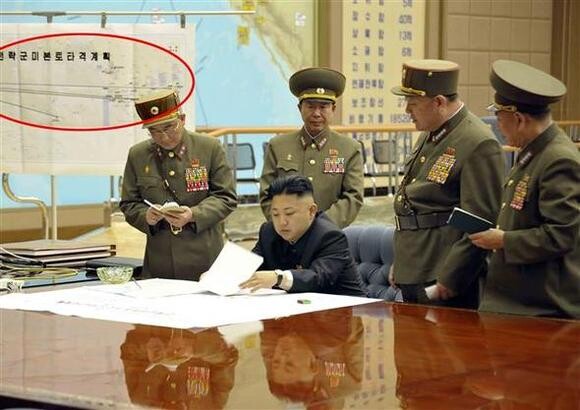hankyoreh
Links to other country sites 다른 나라 사이트 링크
US media showing alarm over North Korean rhetoric

By Park Hyun, Washington correspondent
There are various reactions within the US to North Korea’s announcement that it has drawn up plans to strike the continental US and to its declaration of a state of war between North and South Korea.
The US media has drawn attention to a chart with the phrase “US mainland strike plan” that can be seen in a picture taken at a Mar. 29 meeting of North Korean leader Kim Jong-un and heads of the DPRK military. The New York Times ran a front-page article on the story, while CNN and Fox News treated it as major news all day on Mar. 30 (EST).
While the media expressed doubts that North Korean threats will actually be carried out, they said that the possibility of a miscalculation leading to a limited military confrontation could not be ruled out. “U.S. military commanders are closely watching the situation,” the Washington Post reported, adding, “the rising tensions increase the risk of some form of limited armed conflict.”
The New York Times noted that a country that is about to launch a military attack doesn’t broadcast its attack plans to the entire world, suggesting that North Korea’s propagandists and firebrands have made Kim Jong-un look like an inexperienced leader. The paper also expressed its doubts that North Korean leaders really intend to launch missiles at the US, as they are aware that doing so would mean their own downfall.
According to experts, North Korea has improved its nuclear and long-range missile capabilities, but it is not yet able to strike the continental US. However, there are concerns that the North could target US forces stationed in South Korea, Japan, Guam, and other areas.
CNN interviewed Christopher Hill, who led the US delegation to the six-party talks during the presidency of George W. Bush and who is currently dean of the Josef Korbel School of International Studies at the University of Denver. “I don’t think that North Korea’s missiles pose an actual threat to the US,” Hill said. The real danger, he argued, is that the US could end up getting involved in an attempt to defend South Korea if the South responds to North Korean provocations.
There are also a variety of views about North Korea’s warlike rhetoric. “Since North Korea is making stronger threats that are lasting longer than before, they must not be ignored,” Hill said. “This is connected with domestic politics in North Korea. The military establishment is trying to impress upon ordinary North Koreans that Kim Jong-un is a tough leader.”
[%%IMAGE2%%]In an article that CNN ran on its website, Scott Snyder, senior fellow at the Council on Foreign Relations suggested that North Korea’s recent behavior is due to the fact that the country’s self-defense mechanism for controlling internal and external pressure has gone into overdrive.
Snyder writes, “North Korea has long used its bluff and bluster as a form of self-defense to keep potential enemies off guard, to strengthen internal political control, magnify external threats to promote national unity, and to symbolically express dissatisfaction when international trends are not going its way. This year, converging factors are squeezing North Korea, creating a stronger-than-usual response in the face of seemingly greater international pressure.”
According to Snyder, “But the intensity and frequency of threats in Kim Jong Un’s first year of leadership is uncomfortably high, raising questions about whether junior Kim fully understands the ritualistic rules of the inter-Korean ‘threat-down’.”
Please direct questions or comments to [english@hani.co.kr]

Editorial・opinion
![[Column] Season 2 of special prosecutor probe may be coming to Korea soon [Column] Season 2 of special prosecutor probe may be coming to Korea soon](https://flexible.img.hani.co.kr/flexible/normal/500/300/imgdb/original/2024/0426/3317141030699447.jpg) [Column] Season 2 of special prosecutor probe may be coming to Korea soon
[Column] Season 2 of special prosecutor probe may be coming to Korea soon![[Column] Park Geun-hye déjà vu in Yoon Suk-yeol [Column] Park Geun-hye déjà vu in Yoon Suk-yeol](https://flexible.img.hani.co.kr/flexible/normal/500/300/imgdb/original/2024/0424/651713945113788.jpg) [Column] Park Geun-hye déjà vu in Yoon Suk-yeol
[Column] Park Geun-hye déjà vu in Yoon Suk-yeol- [Editorial] New weight of N. Korea’s nuclear threats makes dialogue all the more urgent
- [Guest essay] The real reason Korea’s new right wants to dub Rhee a founding father
- [Column] ‘Choson’: Is it time we start referring to N. Korea in its own terms?
- [Editorial] Japan’s rewriting of history with Korea has gone too far
- [Column] The president’s questionable capacity for dialogue
- [Column] Are chaebol firms just pizza pies for families to divvy up as they please?
- [Column] Has Korea, too, crossed the Rubicon on China?
- [Correspondent’s column] In Japan’s alliance with US, echoes of its past alliances with UK
Most viewed articles
- 1‘We must say no’: Seoul defense chief on Korean, USFK involvement in hypothetical Taiwan crisis
- 2[Column] Season 2 of special prosecutor probe may be coming to Korea soon
- 3N. Korean delegation’s trip to Iran shows how Pyongyang is leveraging ties with Moscow
- 4Amnesty notes ‘erosion’ of freedom of expression in Korea in annual human rights report
- 5Korea sees more deaths than births for 52nd consecutive month in February
- 6[Reportage] On US campuses, student risk arrest as they call for divestment from Israel
- 7[Editorial] New weight of N. Korea’s nuclear threats makes dialogue all the more urgent
- 8‘Weddingflation’ breaks the bank for Korean couples-to-be
- 9Division commander ordered troops to enter raging flood waters before Marine died, survivor says
- 10[Editorial] Korea’s surprise Q1 growth requires objective assessment, not blind fanfare